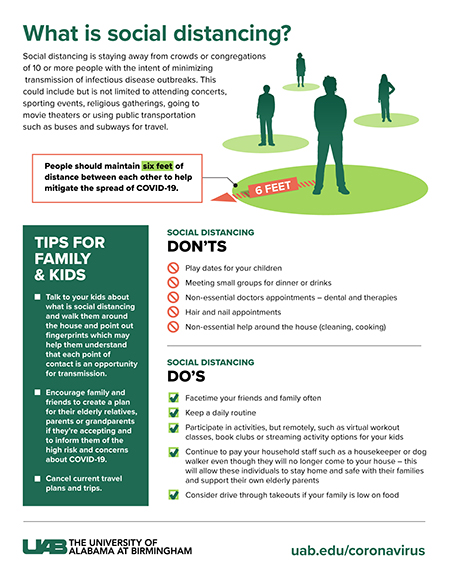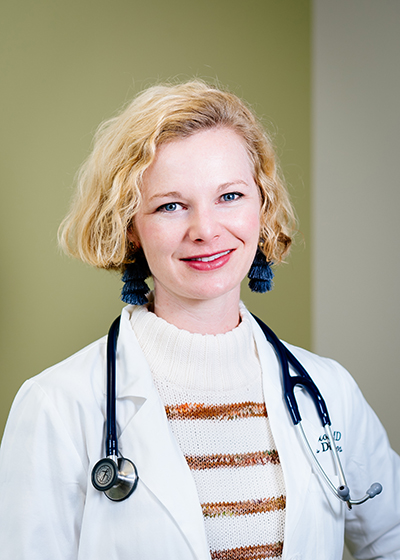Editor's Note: The information published in this story is accurate at the time of publication. Always refer to uab.edu/uabunited for UAB's current guidelines and recommendations relating to COVID-19.
 As the global pandemic COVID-19 continues to rapidly spread, many are hearing the term social distancing. But what does social distancing actually mean, and why does it matter for the greater good of our society during this uncertain time?
As the global pandemic COVID-19 continues to rapidly spread, many are hearing the term social distancing. But what does social distancing actually mean, and why does it matter for the greater good of our society during this uncertain time?
Social distancing is staying away from crowds or congregations of 10 or more people with the intent of minimizing transmission of infectious disease outbreaks.
The Centers for Disease Control and Prevention defines social distancing as “remaining out of congregate settings, avoiding mass gatherings and maintaining distance — approximately 6 feet or 2 meters — from others when possible.” Social distancing is recommended because medical professionals know that the virus that causes COVID-19 can travel at least 3 feet when coughed or sneezed and can live on surfaces for hours to days.
Dr. Ellen Eaton, M.D., assistant professor in the Division of Infectious Diseases at the University of Alabama at Birmingham, says that social gatherings of any type with anyone other than your immediate family are no longer safe for the community.
“We now believe that a significant number of asymptomatic individuals are unknowingly transmitting COVID-19 in the community,” Eaton said. “This is especially concerning because we do not have the capacity or infrastructure to rapidly test large numbers of individuals at this time, so we are testing the symptomatic — those with fever or who have had close contact with an infected individual. In this scenario, the most effective way to halt transmission is to ask the entire community to practice social distancing.”
Social distancing – Don’ts
- Play dates for your children.
- Meeting small groups for dinner or drinks.
- Non-essential doctor and medical appointments, including dental and therapies.
- Hair and nail appointments.
- Non-essential help around the house (cleaning, cooking).
| Get the latest COVID-19 information at uab.edu/coronavirus. |
Eaton says, because COVID-19 can live for hours on surfaces, elevator buttons, doorknobs and bathroom sinks may allow transmission to go unchecked, and that these are all prime ways for us to transmit the virus to our hands and then to others.
For mental health and wellness, there are several ways to keep your life as normalized as possible by doing the following:
Social distancing – Do’s
- Facetime your friends and family often.
- Keep a daily routine.
- Participate in activities, but remotely, such as virtual workout classes, book clubs or streaming activity options for your kids.
- Continue to pay your household staff such as a housekeeper or dog walker even though they will no longer come to your house; this will allow these individuals to stay home and safe with their families and support their own family members who may be at elevated risk.
- Consider drive-through takeout if your family is low on food.
 As the global pandemic, COVID-19, continues to rapidly spread, many have been hearing the term social distancing. Learn from UAB expert, Ellen Eaton, M.D. about what is social distancing, why it’s important and what all you need to know.How social distancing can protect my family and others
As the global pandemic, COVID-19, continues to rapidly spread, many have been hearing the term social distancing. Learn from UAB expert, Ellen Eaton, M.D. about what is social distancing, why it’s important and what all you need to know.How social distancing can protect my family and others
To better help your kids understand about social distancing and how germs travel, Eaton suggests walking them around the house and pointing out fingerprints, which may help them understand that each point of contact is an opportunity for transmission.
“My boys leave fingerprints around the house and car, like most kids,” Eaton said. “Even though we don’t eat on the couch, I often find ketchup thumb prints there. I am also often wiping fingerprints off around the light switches, mirrors and car windows.” By showing them all the ways they interact with their environment, parents can use it as an opportunity to reinforce hand hygiene.
When it comes to convincing your elderly or older parents/grandparents to stay put for a while, Eaton is encouraging others to inform them of the risk and concerns and help them plan if they are accepting. But if not, she encourages people to invest their energy and resources on other vulnerable groups and the organizations that serve them — such as the homeless, shelters or the incarcerated — because this may be more productive and beneficial for the community.
“I think many will not appreciate the risk and may be late to start distancing themselves until the virus is widespread in the community and they are potentially already infected,” she said.
Canceling current travel plans and trips is also a big factor to positive social distancing.
“Road travel and all other activities should be reserved for only essential activities,” Eaton said. “COVID-19 is rapidly forcing shutdowns of cities and towns, including restaurants and entertainment venues. The last thing these communities need is another family in need of emergency food or health care in the event of an untimely restaurant closure or fender bender.”
Eaton says to save your vacation for the warm and humid summer months, when we hope COVID-19 transmission will slow and our routines will normalize.
For more information about COVID-19, visit UAB’s official resource page.